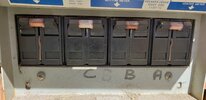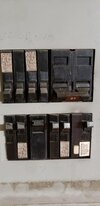Hi
I've been reading to a lot of various topics in this forum about Teslas and I finally ordered a LR MY myself last month, it won't come for a long awhile but it's ok I can wait. I finally decided to create an account so I can ask questions here and hopefully can get some insights.
I've been contacting various licensed and one non-licensed electricians recently. I live in a condo and only have a 70 amp main breaker (pic attached, I'm unit#A). The one non-licensed electrician came and said I can install a NEMA 14-50 with no problem and gave me a quote (which is cheapest out of all the ones that came). Then the other licensed electricians came in various times in the next few days and each came to my place and look at the panels, three of them saids the max I can do is 14-30 without tripping the circuit (14-50 is not possible they said) and the last one came yesterday and said he wouldn't even risk doing a 30amp if I hired him and tell me to just stick with a 5-15, it would most likely trip the circuit or maybe worse.
Am I really out of luck? Anyone else have a similar situation like me? 5 electricians came, and they all gave a different answer. I'm so frustrated and this has cause so much anxiety. My dream would be to install a 14-50, but I would be ok to go with a 14-30, just not the 5-15. I just want to get the fastest without burning down my house.
I've been reading to a lot of various topics in this forum about Teslas and I finally ordered a LR MY myself last month, it won't come for a long awhile but it's ok I can wait. I finally decided to create an account so I can ask questions here and hopefully can get some insights.
I've been contacting various licensed and one non-licensed electricians recently. I live in a condo and only have a 70 amp main breaker (pic attached, I'm unit#A). The one non-licensed electrician came and said I can install a NEMA 14-50 with no problem and gave me a quote (which is cheapest out of all the ones that came). Then the other licensed electricians came in various times in the next few days and each came to my place and look at the panels, three of them saids the max I can do is 14-30 without tripping the circuit (14-50 is not possible they said) and the last one came yesterday and said he wouldn't even risk doing a 30amp if I hired him and tell me to just stick with a 5-15, it would most likely trip the circuit or maybe worse.
Am I really out of luck? Anyone else have a similar situation like me? 5 electricians came, and they all gave a different answer. I'm so frustrated and this has cause so much anxiety. My dream would be to install a 14-50, but I would be ok to go with a 14-30, just not the 5-15. I just want to get the fastest without burning down my house.




